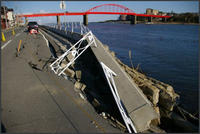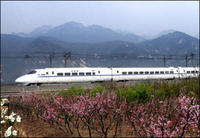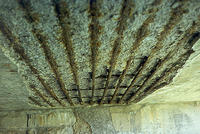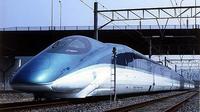-
Averting bridge disasters: new sensors could save hundreds of lives
One of every four U.S. highway bridges has known structural problems or exceeded its intended life-span. Most only get inspected once every one or two years; University of Maryland researcher has developed a new sensor that measures indicators of a bridge’s structural health, such as strain, vibration, flexibility, and development of metal cracks; the sensors are expected to last more than a decade, with each costing about $20
-
-
Earthquakes: scientists will shake 5-story building in Japan
Landmark earthquake engineering tests this summer in Japan could open the door for earthquake-proofing technology applied to hospitals, nuclear power plants, and emergency-response facilities to be more common in the United States, and confirm the capabilities for the technology used in Japan and the rest of the world
-
-
Bridge destruction to offer clues about 'fracture-critical' spans
A civil engineer at Purdue University is taking advantage of the demolition of a bridge spanning the Ohio River to learn more about how bridges collapse in efforts to reduce the annual cost of inspecting large spans
-
-
Sensing "skin" protects concrete structures
Scientists have developed a sensing “skin” which is made of stretchy thermoplastic elastomer mixed with titanium dioxde; patches of the skin are painted with black carbon to measure changes in the electrical charge of the skin; the skin will be rolled out in patches across structures such as bridges and dams; the formation of a crack would cause a movement in the concrete under the patch, which would change the capacitance, or stored energy, of the skin; daily check by computers would detect the change the capacitance, and issue and alert
-
-
Studying the Japan quake's impact on soil will improve building design

The 11 March quake that hit Japan weakened subsurface materials by as much as 70 percent; that nonlinear response from the top layer of the Earth’s crust affected how the movement of faults deep beneath the surface was delivered to buildings, bridges, and other structures; understanding how the soil responds to powerful earthquakes could be important to engineers and architects designing future buildings to withstand the level of acceleration measured in this quake
-
-
Quake-resistant superelastic alloy developed
Japanese scientists added a small amount of nickel to an iron-based alloy, and found that the new material can recover its original shape at any temperature from -196 to 240 degrees Celsius; the material may be used in environments that are constantly exposed to extreme temperatures, such as joints and controls in cars, planes, and spacecraft; it may also help buildings cushion stress and violent movement in earthquakes
-
-
"Sensing skin" to monitor concrete infrastructure health inexpensively
In 2009, the American Society of Civil Engineers (ASCE) assigned the grade D to the overall quality of infrastructure in the United States and said that ongoing evaluation and maintenance of structures was one of five key areas necessary for improving that grade; civil engineers recently proposed a new method for the electronic, continual monitoring of structures
-
-
RAILENIUM awarded 550 million Euro boost from French government
RAILENIUM, the European Institute for Technological Research in Rail Infrastructure, has been selected by the French government as a leading investment project and has been awarded 550 million Euros in funding; the equipment and research platforms that RAILENIUM will provide will be unique in Europe; this will include a 5 km rail test loop, a tramway test track, a fatigue-simulation track, running trial facilities, and service structures
-
-
New building material could help solve bridge woes
With infrastructure in the United States rapidly aging and in need of repair, new building materials made in Maine that make bridges cheaper, lighter, and more durable could help cash starved states undertake critical infrastructure investment; using lightweight hybrid composite beams, the Maine Department of Transportation (MDOT) has just completed the largest composite bridge in the world; the new bridge is projected to last at least 100 years; the material’s weight, cost, and durability have generated a lot of interest across the country
-
-
China reduces top speed on high-speed rail

On Monday Chinese officials lowered the top operating speed for its flagship bullet train citing safety concerns; China’s Railway Ministry will now run trains at 155 to 186 miles per hour on the Beijing to Shanghai line instead of 236 miles per hour as was originally planned; the recent announcement comes as part of broader set of changes to the Railway Ministry after Liu Zhijun, the previous minister, was fired for corruption and mismanagement in February
-
-
Larry Summers calls for $100 billion in infrastructure spending
A former chief White House economic advisor is urging lawmakers to approve $100 billion in additional infrastructure spending to help boost the economy and prevent stagnation; Larry Summers, the former director of the White House National Economic Council for President Obama, wrote that it would be “premature” to limit fiscal support for the economy at the end of 2011
-
-
Truckers push for more highway spending
Last month truckers pushed Congress to increase investments to America’s highway system noting that cargo shipped by trucks was expected to increase sharply over the next decade; the American Trucking Association (ATA) recently predicted that by 2022, there will be an overall increase of 24 percent in freight transportation; of that 24 percent, the trucking industry will see its cargo load increase by 70 percent.
-
-
New concrete could increase life of bridges by forty years

Researchers have developed a new type of concrete that could increase the lifespan of bridges by more than forty years compared to normal strength concrete; the more durable type of concrete minimizes shrinkage, a problem typically found in high-strength concrete; the new concrete is also less likely to crack, which reduces the ability for corrosive materials like chlorides from de-icing salts to seep into the bridge’s internal structure; the new concrete uses a lightweight porous type of sand
-
-
Making high-speed rail tracks safer

High-speed rail requires prestressed concrete railroad ties, as wooden cross ties are too flexible; for these ties to be effective, prestressing forces must be applied at a considerable distance before the rail load is applied; this is called the transfer length; to resist the heavy impacts the concrete ties utilize about twenty steel wires, each stressed to around 7,000 pounds; if the prestressed force is not properly transferred, failures can occur in the track
-
-
Senators outline long-term transportation spending plan
On Wednesday, a bipartisan group of senators announced that they had come to an agreement on a long-term transportation spending bill; since 2008, highway and transit construction programs have had an uncertain fate, but the proposed bill would allocate roughly $56 billion a year to highway and transit construction; it is unclear what the final bill will look like as the Senate, House, and executive branch each have diverging views on highway funding; funding the transportation bill will be no small feat; a two year Senate bill would require $12 billion in additional fuel tax revenues and a six year bill would require an addition $70 billion
-
- All
- Regional
- Water
- Biometrics
- Borders/Immig
- Business
- Cybersecurity
- Detection
- Disasters
- Government
- Infrastructure
- International
- Public health
- Public Safety
- Communication interoperabillity
- Emergency services
- Emergency medical services
- Fire
- First response
- IEDs
- Law Enforcement
- Law Enforcement Technology
- Military technology
- Nonlethal weapons
- Nuclear weapons
- Personal protection equipment
- Police
- Notification /alert systems
- Situational awareness
- Weapons systems
- Sci-Tech
- Sector Reports
- Surveillance
- Transportation
Advertising & Marketing: advertise@newswirepubs.com
Editorial: editor@newswirepubs.com
General: info@newswirepubs.com
2010-2011 © News Wire Publications, LLC News Wire Publications, LLC
220 Old Country Road | Suite 200 | Mineola | New York | 11501
Permissions and Policies
Editorial: editor@newswirepubs.com
General: info@newswirepubs.com
2010-2011 © News Wire Publications, LLC News Wire Publications, LLC
220 Old Country Road | Suite 200 | Mineola | New York | 11501
Permissions and Policies
